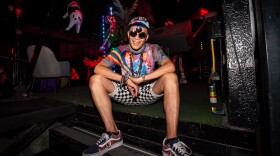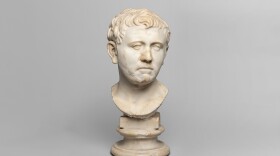This story was originally performed live at the Paramount Theatre on Sept. 28, 2022.
A few years ago, my daughter, June, asked me a question I wasn't sure how to answer. So I told her to ask it for ATXplained.
"What is the most, like, valuable thing you can find in a museum in Austin, Texas?" she asked.
I don't think we have any Picassos or Van Goghs on public display here in the Live Music Capital of the World. Austin is not exactly well-known for its museums (though we do have some good ones).
So I went to what's probably the biggest museum in town — the Blanton Museum of Art — to see what it has in the way of "valuable" things.

Blanton Museum of Art
The first thing the curators showed us was an installation by the Brazilian artist Cildo Meireles called Missão/Missões (Mission/Missions) or How to Build Cathedrals. It's made of 600,000 pennies, 800 communion wafers, 2,000 cattle bones and 80 paving stones. It represents colonization in Brazil and the conversion of indigenous tribes to Catholicism.

With all those pennies in it, we know it's worth at least $6,000 — but obviously it's worth more. How much? We don't know exactly. I was told most museums don't reveal the value of their exhibits for insurance purposes.
The other thing we saw was just outside the museum.

Austin, which opened in 2018, is the only building ever designed and built by artist Ellsworth Kelly. It cost $23 million to build and fund its future maintenance, but who knows how much it would be worth if it could be sold now. (Not even sure how you would sell this building?)
The Harry Ransom Center
Not far from the Blanton, the Harry Ransom Center has all kinds of historical artifacts and papers from famous people. But it also has one of a handful of remaining complete copies of a Gutenberg Bible, one of the first mass-produced books made using metal type. It was bought in 1978 for $2.2 million; there are estimates that complete copies like this could sell for more than $25 million today.

As far as I can tell, this is the most expensive thing we've got in a museum. That got me thinking: Austin is the 11th largest city in the country. We're the capital of the second-most-populous state. We've got a frickin' Formula One racetrack. Why don't we have more expensive art?
"A lot of the wealth in Austin is very new. It doesn't go back three or four generations," said Doug Dempster, the former dean of UT's College of Fine Arts. "When you look at Houston and Dallas and Fort Worth, you can see 100 years of wealth that's invested very intentionally in building the cultural infrastructure of those communities."
In fact, Dempster says, Austin shouldn't even try to compete with big museums in other states — or even other museums in Texas — for no other reason than their pockets are so deep, it would be impossible to compete. But more than that, he says, Austin already has its own unique brand.
"What makes ATX the brand that it is, is partly that it's rising on a tide of creative artists and performers," he said. "And that's way more distinctive and interesting than trying to compete at this flagship level with elite institutions."
So let's not focus on the expensive stuff. In fact, that really wasn't the question June was asking anyway.
"I don't mean the thing that's worth the most amount of money. I mean the most, like, precious thing to the people," she said.
OK, well let's go on a search for valuable things — the things most precious to the people.

Back to the Blanton
The first thing I want to look at is the value of listening. Sound artist Henna Chou composed this piece for the Blanton's "SoundSpace: Conversation Pieces" video series earlier this year.
While there wasn't a live audience for this particular piece, Chou has also done performances at the Blanton and The Contemporary.
"It's kind of special because you don't get a response right away when people are listening, since they're supposed to wait the whole time," she said.
There's something special about experiencing visual art and sound in a museum space.
"I really appreciate the idea of having a quiet audience," she said. "Everyone engaging in the practice of listening and the practice of being peaceful together. That is kind of a unique thing that people don't have all the time."
Watch the video above and tell me that's not a valuable experience.
The Bob Bullock Texas State History Museum
Now: the value of perspective — the kind of perspective you can only get from something thousands of years old.
I asked Angie Glasker, the curator of the Bob Bullock Texas State History Museum, what she thought the most valuable thing in the museum is. She pointed me to this tiny piece of rock.

It's a broken projectile point — like an arrowhead — found at an archeological dig site just north of Georgetown. The artifact itself isn't particularly unique, but it is old. Scientists thought the first people arrived in this part of the world about 13,000 years ago, but this human-made object — found in Central Texas — is at least 16,000 years old. That indicates our understanding of humans' arrival here was way off.
"So this tiny, broken arrow point actually significantly changed the way that we scientifically think about the peopling of the Americas," Glasker said.
Sometimes, something comes along that shows us we need to reevaluate our assumptions — our entire concept of the world.
"If you talk to indigenous people, they were always here. This is where they're from — they've always been here," Glasker said. "Scientifically, we keep pushing that date back further and further and further. So I think at some point science and indigenous knowledge are going to meet."
A tiny thing that changes our entire notion of human development? Priceless.
The George Washington Carver Museum
A thing doesn't have to be thousands of years old to deepen our understanding of our fellow humans, though. It can be something left behind by our parents or grandparents.
The George Washington Carver Museum in East Austin is dedicated to preserving the history of Black people in Austin. Collections Manager Alan Garcia showed me a leather scrapbook. One day during the pandemic, he said, someone came up to the museum and left it on the ground by the front door.
"What happens often is that they drop it off to a museum because it was an item they discovered in a house that they just purchased, you know, family history that's been left behind in a property in East Austin that changed hands rapidly," Garcia said.
The scrapbook belonged to the family of a man named Milo Payne. He served in the Army during World War II and later worked at the Texas Capitol as the supervisor of special services. His job was to prepare the House chamber for regular business and special occasions, like visits from dignitaries.
Garcia calls the scrapbook priceless history.
"Especially this perspective, right? African-American perspective behind the scenes at the Capitol," he said. "Extremely rare. One of a kind."
Milo Payne died in 1995.
"I don't think communities of color get enough credit for being the ones who are preserving their story," Garcia said. "When I look at all these scrapbooks and see all the care that goes into it, they deserve all the credit for being the ones who made a point to save these images, save these stories."
The Museum of Ice Cream
We're going to change the vibe up a little here, with a visit to The Domain, where you can find The Museum of Ice Cream.
Now, this isn't a museum in the traditional sense, but I went because ... I wanted to go there. There aren't really exhibits here, just a series of rooms seemingly built to be the backdrop for Instagram posts and TikToks. There's also lots and lots of free ice cream.
"There's a reason that maybe you need to spark joy in your life and that's why you're coming to the Museum of Ice Cream," said Annie Dukes, the museum's manager.
The joy of wading into a pool full of oversized plastic rainbow sprinkles. Navigating through a room of plastic bananas hanging from the ceiling. Playing whack-a-mole that's ice cream instead of moles.
And then there's the rainbow hallway. Here, you can blow up a balloon, write a wish on it and toss it into the hallway to make your wish come true.
Looking through the balloons, I found one wishing for "Happiness for everyone." Another for "5 billion penguins."
But then this one: "I want to go to Alaska and see my Dad!"

I don't know if this was one wish or two — Is their dad in Alaska? But it seems clear this person misses him enough to wish to see him on a balloon and cast it into this hallway in hopes it will come true.
This might have been the most precious thing I found in a museum, if it weren't for one other place I visited.
The Texas Toy Museum
If you're of a certain age — if you grew up in the '80s and '90s — this place is magical. It's got every toy you remember from your childhood and some you don't remember.
"I hear a lot of people come in and talk about how it's unlocking childhood memories when they see their friends from their childhood," said Caleb Zammit, the museum's owner. "That's what I see it as — more of a museum of memories."
G.I. Joe. Ninja Turtles. Barbie. My Little Pony. Old arcade games. An X-Men #1 comic book that Zammit says is worth about $15,000.
But if you ask what toy in the entire museum is most valuable to him, he pulls out an old Star Wars action figure. It's missing its arms and head.

"This one was one I had when I was little. I had it with me when my dad was really sick in the hospital," he said. "So we would take it around — throw it around — me and my brother. And eventually it fell totally apart, but I still keep it as a memory."
His dad was in and out of the hospital before he died. Zammit sees this broken old toy as a memory of a bad time, but something that got him through that bad time.
It's not a painting or a building or a historical artifact. It's a headless, armless token of a time long past, but always present.
"There could be a $5 toy that nobody cares about but to somebody, that was their whole world when they were 5 years old," Zammit said. "There's a lot of emotion based on the things we were given with love — and loved — when we were little."
Things loved and given with love. This was the only museum where I found that. And I can't imagine anything more valuable than that.
What valuable things did I miss? Submit your own ideas for the most precious thing in a museum in Austin below.
_































